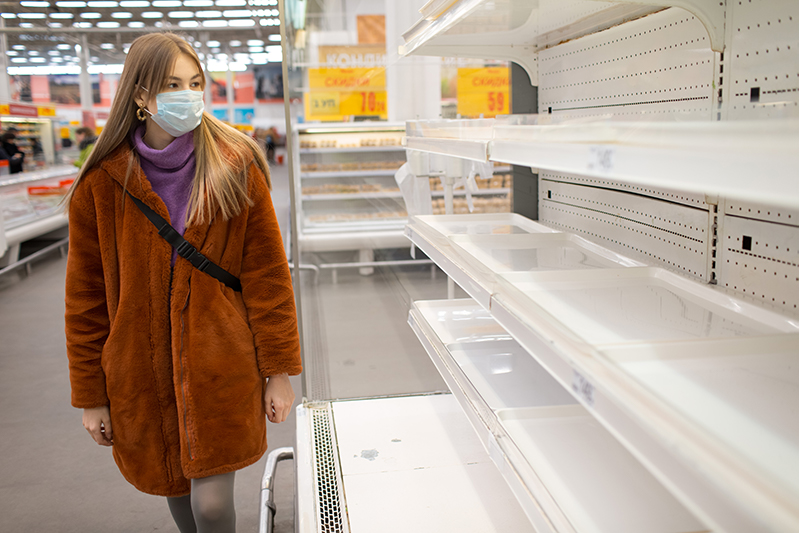


Shifting food norms
Photo by iStock March 24, 2021
Pandemic may have lasting effects on food purchasing and waste behavior
In a typical year, many Americans grocery shop without concern and spend more than half of their food budgets dining out at restaurants, bars and other venues away from home. But 2020 was not a typical year. Consumer behaviors and attitudes toward grocery shopping, public gatherings and the safety and stability of our food systems have all shifted in unpredictable but lasting ways.
Brandon McFadden, assistant professor in the University of Delaware’s Department of Applied Economics and Statistics, and his colleagues have conducted surveys since news of the coronavirus (COVID-19) pandemic broke and mitigation efforts began. They’ve monitored the ways in which the public health crisis has impacted our behaviors like food purchasing, pantry management and food waste, and shaped our concerns about environmental regulatory changes and virus transmission.
“One of the big lessons we learned is that the food system is a lot more fragile than most people previously thought,” said McFadden. “I think it was a shock to people at the beginning of the pandemic when we saw things like stockouts and suddenly when you go to the grocery store you can’t get the things you expected to buy. People didn’t realize that most of our food is typically packaged to supply to restaurants and hospitals, not necessarily for our homes. Our food system just wasn’t ready for such a dramatic shift in purchasing behavior. But I think we also saw how resilient our food system can be because it bounced back pretty quickly despite the impacts of this pandemic.”
One of the earliest changes McFadden and his colleagues noted was the shift from spending money on food away from home to spending more for meals at home. This largely coincided with pandemic restrictions and restaurant closures, though it was offset slightly by takeout orders. Because dining out is often viewed as a luxury, researchers believe it may be slower to return to pre-pandemic levels due to historic unemployment rates and reluctance to return to indoor dining. The rise in unemployment could also indicate that consumers have more time to devote to meal planning and preparation, thereby decreasing expenditures on dining out.
Considering this shift toward eating at home, researchers also examined pantry management and food waste changes. According to the U.S. Department of Agriculture, Americans waste 30-40% of their food in a normal year. McFadden notes that most of this waste happens with food purchased away from home, either from food left on the plate in restaurants or from leftovers carried home and later discarded. Because fewer consumers are eating out, researchers expect that food waste will decrease. Stockpiling behavior at the grocery store could have the opposite effect and actually increase waste, but many consumers reported filling their pantries with paper products and shelf stable foods in an effort to avoid frequent grocery shopping trips.
With his College of Agriculture and Natural Resources colleagues Maik Kecinski and Kent Messer, McFadden also surveyed consumer concerns about virus transmission, both from grocery shopping and from food consumption. Despite statements from both the U.S. Food and Drug Administration and the U.S. Centers for Disease Control and Prevention indicating that there is no evidence for COVID-19 transmission due to the handling and consumption of food, consumers expressed multiple concerns. While respondents were most concerned about virus exposure while shopping, the number of consumers concerned about transmitting the virus from consuming food rose steadily over months of data collection. This may be attributable to news of the virus originating in a wet market or the virus outbreaks at food processing facilities creating a connection between food and COVID-19. Survey results also indicated that Black respondents were more concerned about virus transmission through certain staple foods, indicating that the pandemic could lead to persistent food stigmas, potentially intensifying racial inequities related to food and nutrition.
“It seems as though the relationship between food and transmission of COVID-19 has not been communicated well. There are risks of exposure when in public spaces but currently many consumers do not have the necessary information to prioritize risks,” said McFadden.
McFadden notes that much of this research is exploratory, rather than explanatory. Because the current pandemic is unprecedented, researchers can’t rely on historical data to predict future behaviors. “As an economist, if this were a short lived thing, I’d say that you’d see businesses on the margins shut down, making room for new businesses to immediately fill that space when the economy recovers,” said McFadden. “If this continues to last, I just don’t know. The longer this goes on, the more we’ll see places shut down, a greater shift to online shopping, and probably the consolidation of grocery stores and other businesses. We may also see lasting behavior shifts in the way people interact with our food system like how they purchase and consume food. We’re working to determine how people are responding now and where they think they’ll be in a week, month or year into the future.”
Contact Us
Have a UDaily story idea?
Contact us at ocm@udel.edu
Members of the press
Contact us at 302-831-NEWS or visit the Media Relations website

